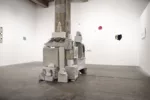America is still feeding off it’s old myths–the cowboy and the limitless landscape, the road-trip escape, the huckster medicine show, the American Dream, home sweet home, the decorous South, the heroic founding fathers, the grass-roots democracy.
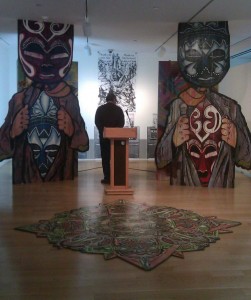
The show here. at the Pennsylvania Academy of the Fine Arts is full of lively art that reimagines the nation’s old myths in terms of current realities. And the resulting show is a festival of Americana that dares to dream in big new ways that recreate and revitalize the nation’s creation myths and self-images. So the important here-ness of the show is not so much about particular regions of the country, although there’s some of that. It’s about who we are as Americans. Here’s some of what I admired:

Sue Chenoweth’s map-like renderings recall Native American maps on deerskin and the trek across the Candyland gameboard! The central, non-Western orientation in these landscapes turns each of these works into a creation myth. Each piece suggests that what you are seeing is the entire world.
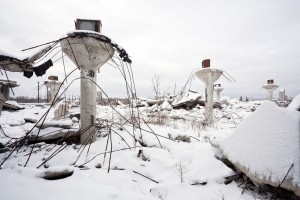
Another artist creating his own mythic tale of the place where he lives is Scott Hocking. His Garden of the Gods series of devastated landscapes plus landscape interventions are like archaeological digs into he glories of the past.
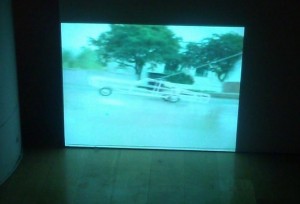
Chido Johnson’s video of a man (the artist I presume) walking the outline of a car on a leash is a poignant testament to imagination, yearning and the American Dream reduced to a pet car. This reminds me of South African video artist Robin Rhodes interacting with his chalk drawings as if they were the real thing.
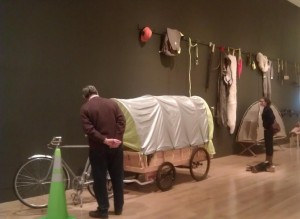
Abigail Anne Newbold’s Homemaker series summons visions of Westward, Ho! all tidied up with Shaker tastes and green values. Newbold finds transcendent glory in her tidied homestead on wheels at the same time that she inserts neediness and making do into the romance of the camping home on the range that’s no longer limitless.
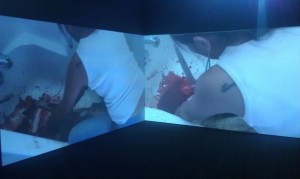
A video of a Native American ritual lamb slaughter in a motel bathtub, by Postcommodity, is a jolting displacement. In a way, this gory ritual elevates the seedy motel and its anonymity into a sacred place. At the same time the artists confront our (and PETA’s ? ) squeamish and romanticized misinterpretation of native peoples and their relationship to the earth and our fellow beasts.
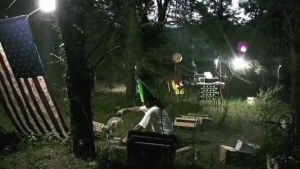
I did not stand for the full 12 minutes in front of Aaron Storck’s loopy video Poetry and Music in Kansas Bush. Another video, nameless, also by Storck (I don’t know the title), was hilarious and riveting. In both the artist stars, bringing a stoner-movie affect to his mix of magician and medicine show huckster. He rants and chants, combining hippie spaciness with talk TV and reality TV. I’m sure there’s more to say and more to see, but I gotta tell you, I loved my little glimpse of his paradise.
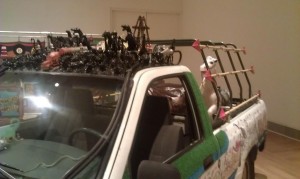
Whether it’s Erika Nelson’s romance with road trips and the kitsch of roadside attractions, or Jennifer Levonian’s battle between lower class and middle class taste, or Guy Michael Davis and Katie Parker’s kitsch descendants of discredited values, the show excavates the the things we treasure as a nation and rewrites newer, truer stories for the 21st century. Here are some more pix:
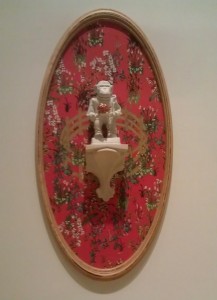
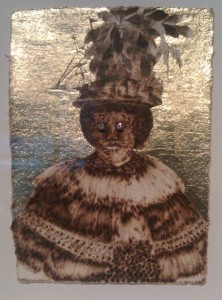

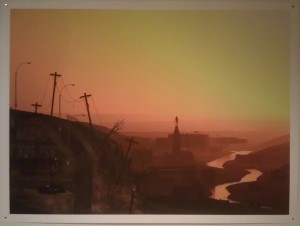
Others in the show are: Megawords, Paul Coors, Terence Hammonds, Liz Cohen, Lewis Colburn, elsewhere, Harrison Haynes, Michael Krueger, Aaron Rothman, Gregory Sale; Glenda Wharton and Whoop Dee Doo (all that was left of Whoop Dee Doo’s performance was a plastic tent).
In some sense this is the perfect PAFA show, contemporary reimaginings of history paintings–mythic, grandiose, and wonderfully dreamy. I’m sorry the show ends the 31st. I’d like to see it again and give it more time.
PAFA Curator of Contemporary Art Julien Robson and five guest curators–Christopher Cook, Director and Curator at the Salina Art Center, Salina, Kansas; Mark Harris, Director of the School of Art at the University of Cincinnati; Rebecca Hart, Associate Curator of Contemporary Art at the Detroit Institute of Arts; Claire Schneider, Independent Curator; and Teka Selman, Assistant Director of the MFA in Experimental and Documentary Arts at Duke University–each selected work from their regions. With them, plus 24 artists or presenting groups, the show is huge, and its catalog is a welcome addition.





